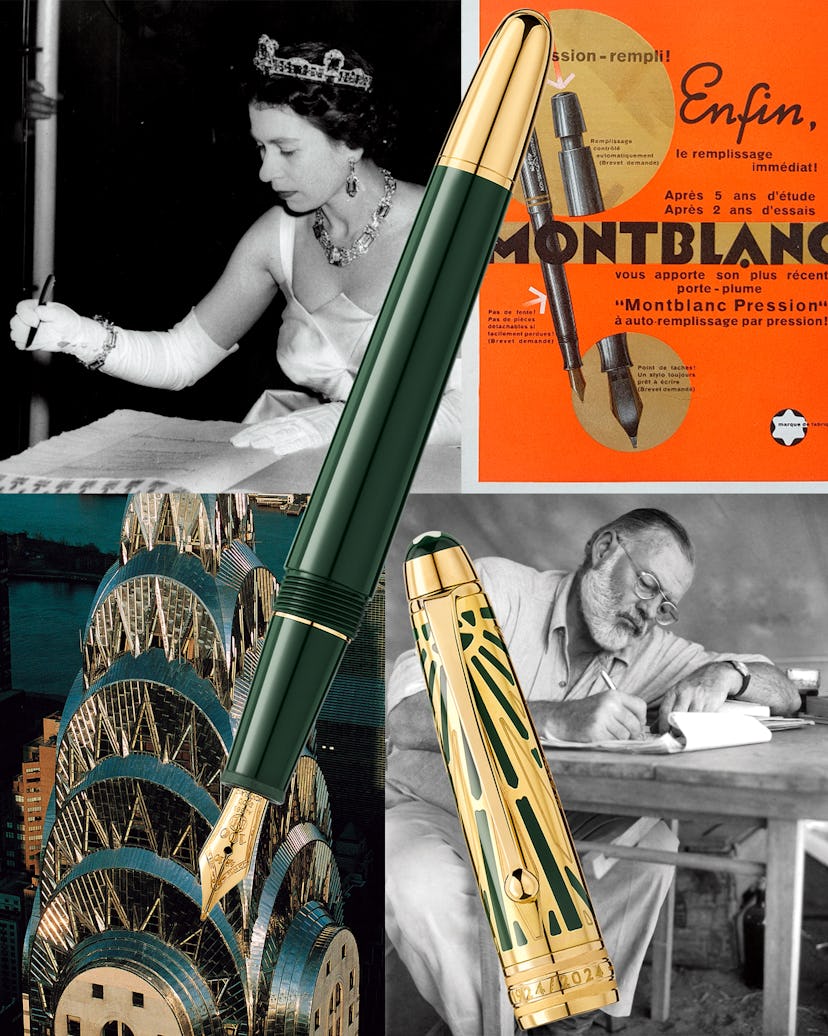How the Montblanc Meisterstück Pen Became the Ultimate Writing Instrument
The pen of choice for authors, artists, and statesmen celebrates its centennial.

In our age of digital supremacy, in which email, tweets, emojis, and a general disregard for elegant prose have conspired to erode the art of handwriting, the pen is alive and well—nowhere more so than at Montblanc. A German company named for the highest peak in the Alps, Montblanc has been at the summit of luxury since its founding, in 1906—an exemplar of innovation and craftsmanship.
The company has appealed to a list of luminaries long enough to line a ski slope—everyone from Queen Elizabeth II and presidents Kennedy, Clinton, and Obama to Ernest Hemingway and Yoko Ono. Montblancs have been used to write everything from love letters and everyday musings to contracts, peace treaties, and documents of historical importance. In 1991, for example, Mikhail Gorbachev signed his resignation as president and commander in chief of the Soviet Union with one of the company’s distinctive pens firmly in hand.
Montblanc’s success is due in no small part to the brand’s iconic Meisterstück. Debuted in 1924, the cigar-shaped design with three gold rings was famously “capped” with a six-pointed emblem symbolizing the Mont Blanc peak. Such is the impact of the Meisterstück that, like a Birkin or a Kelly bag, it is known internationally by its one-word name. The New York Times once called it “a cultural totem for high-achieving business executives.”
“It needs no other justification, context, or acknowledgement,” says the fashion writer Alexander Fury in the definitive company monograph, Montblanc: Inspire Writing. “It is not just Montblanc’s most iconic writing instrument but the most celebrated and famous writing instrument in the world.”
Avid Montblanc pen users have included Queen Elizabeth II, pictured signing the visitors’ book at London’s Royal Festival Hall, 1958.
Montblanc’s Doué Classique fountain pen marks a century of the iconic Meisterstück design with an Art Deco pattern resurrected from the company’s archives.
A 1929 Montblanc ad.
The Meisterstück (or “masterpiece,” loosely, in German) was initially unnamed because it was never meant to be sold; it was created by craftsmen for personal use. In the company’s early days, apprentices would travel the world after graduating, then return with their newfound skills to create their “Meisterstück.” But in 1924, the company decided to offer a Meisterstück to the public, which was eager for the equivalent of a “Sunday best” pen. It spread like ink on blotting paper.
The original has been tweaked over the years, but in 1952 an oversize version was introduced, and the heft and brawn of that model is what we associate with the Meisterstück today. Still, it has continued to evolve, becoming an adaptable canvas to tell inspired stories and reflect cultural changes.
Ernest Hemingway in Kenya, 1952.
Contemporary geniuses like the designer Marc Newson have been brought into the fold to help reimagine the Meisterstück, and great writers of the past, from Robert Louis Stevenson to Edgar Allan Poe, constantly inspire its future. A new Montblanc Meisterstück Around the World in 80 Days collection is informed by Jules Verne’s famous adventure, specifically the part of the journey from Bombay to Yokohama. The cap pays tribute to the length of that journey—25 days. The Doué Classique, seen here, like other offerings from the centennial Origin Collection, arrives with a special nib engraved with 100, as well as the years 1924 and 2024.
One unexpected—and very welcome—outcome of the cyber revolution is the fetishization of objects and experiences that defy digitization. And for as long as people value what they write and how they write it, Montblanc will remain at the apex of penmanship.